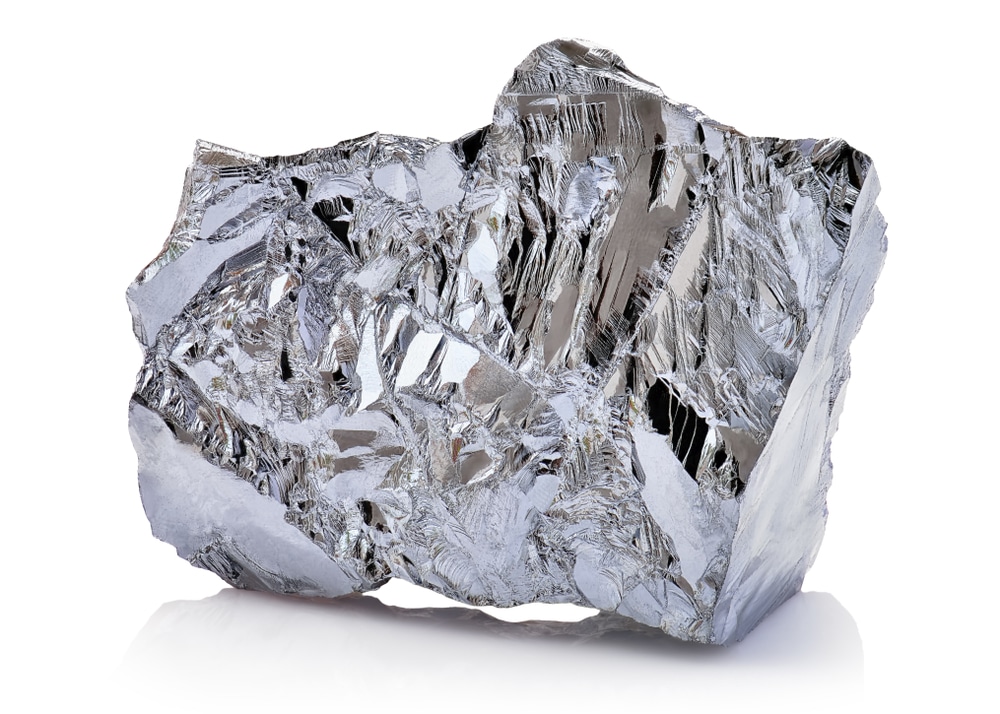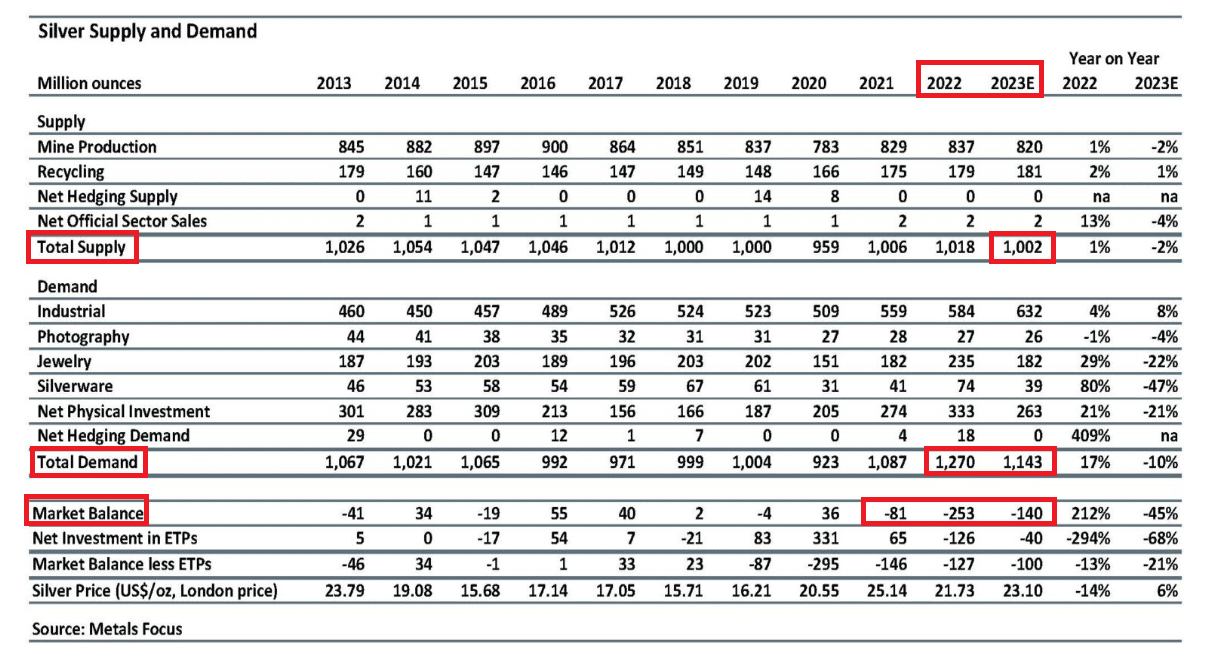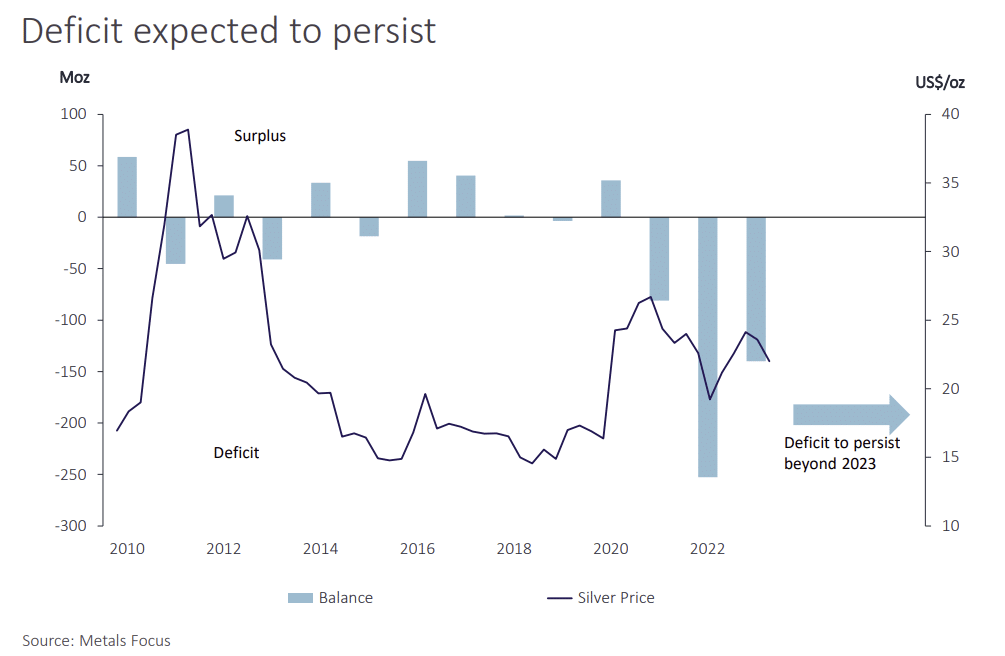The global silver deficit is anticipated to increase by 17%, reaching 215.3 million ounces in 2024. This rise is attributed to a 2% growth in demand primarily driven by robust industrial consumption, coupled with a 1% decline in total supply, as reported by the Silver Institute industry association.
Balancing Demand and Supply Dynamics
Silver, used in various industries including jewelry, electronics, electric vehicles, and solar panels, as well as for investment purposes, is facing its fourth consecutive year of a structural market deficit.
Philip Newman, managing director at consultancy Metals Focus, emphasized that the deficit in the silver market serves as a strong support and foundation for the price. Despite a 30% decrease in the deficit last year, it remained substantial at 184.3 million ounces.
-
While global supply has remained relatively stable around the 1-billion-ounce mark, industrial demand witnessed notable growth of 11%.
However, despite the shortage, visible silver inventories and significant metal stocks held by individuals and investors continue to shield the silver market from immediate pressure.
Newman highlighted that while identifiable silver inventories and off-exchange metal holdings remain considerable, some of these reserves may be tightly held. Consequently, the impact of ongoing deficits on the market remains to be seen.
Reportedly, stocks held in commodity exchange depositories and London vaults experienced a 5% decline last year, amounting to nearly 15 months of global supply by the end of 2023. The majority of the decrease in reported stocks occurred in China, where rapid industrial demand growth of 44% is reshaping local supply/demand dynamics.
Spot silver prices, experiencing an 18% increase year-to-date, reached $29.79 per ounce last week, marking their highest level in over three years, amidst a rally in gold prices and strong copper prices.
Shining Bright in the Solar Revolution
The surge in solar installations and electric vehicle production not only represents a current trend but also serves as a compelling indicator for heightened silver demand. Silver’s unparalleled conductivity and its crucial role in photovoltaic cells position it as a cornerstone in the transition towards renewable energy sources.
The demand for silver in the solar industry has experienced a notable uptrend, accounting for around 5% of the total silver demand in 2014 and expanding to about 14% by the end of 2023.
According to estimates by BloombergNEF, each gigawatt of solar capacity requires approximately 12 tonnes of silver. Using this figure as a basis, the demand for silver in solar panels could witness a substantial surge of nearly 169% by 2030.
This surge would translate to an approximate requirement of 273 million ounces of silver, constituting roughly ⅕ of the total silver demand based on current trend projections.
Much of this growth is attributed to China, which is poised to surpass the total solar panel installations in the United States this year.
Gregor Gregersen, founder of Silver Bullion, emphasizes that the solar industry exemplifies the inelastic demand for silver. Although advancements have enabled the solar sector to become more efficient in its silver use, emerging trends are shifting this dynamic.
Meanwhile, supply is showing signs of strain. Despite a nearly 20% increase in demand last year, silver production remained flat, according to data from The Silver Institute. This year, estimates suggest that production will increase by 2%, yet industrial consumption will climb by 4%.
Silver Squeeze: Meeting Demand Amidst Supply Challenges
However, boosting supply isn’t a straightforward task, given the limited availability of primary mines. Around 80% of silver supply comes from lead, zinc, copper, and gold projects, where silver is a by-product. This strain on supply has led to concerns about future shortages.
A study from the University of New South Wales suggests that the solar sector alone could deplete between 85–98% of global silver reserves by 2050.
Studies are ongoing for alternative technologies using cheaper metals but their viability remains uncertain. Despite current price fluctuations, experts anticipate that substitution will become more appealing as silver prices rise, ultimately leading to a market equilibrium at higher price levels.
As the global silver deficit expands and demand surges, the market faces a complex landscape. The current surge in silver prices reflects market dynamics influenced by industrial consumption and investor sentiment. However, the journey ahead requires strategic planning to address supply challenges and sustain the silver market’s vital role in the transition to renewables and net zero.



 The forecast suggests that the imbalance between supply and demand in the silver market is not a short-term phenomenon but rather a structural issue that is likely to endure in the coming years. This underscores the ongoing importance of silver in various industrial applications and highlights the challenges in meeting the growing demand for this precious metal.
The forecast suggests that the imbalance between supply and demand in the silver market is not a short-term phenomenon but rather a structural issue that is likely to endure in the coming years. This underscores the ongoing importance of silver in various industrial applications and highlights the challenges in meeting the growing demand for this precious metal.